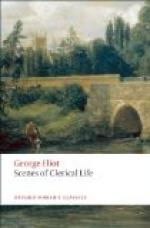Then inside, what dear old quaintnesses! which I began to look at with delight, even when I was so crude a members of the congregation, that my nurse found it necessary to provide for the reinforcement of my devotional patience by smuggling bread-and-butter into the sacred edifice. There was the chancel, guarded by two little cherubims looking uncomfortably squeezed between arch and wall, and adorned with the escutcheons of the Oldinport family, which showed me inexhaustible possibilities of meaning in their blood-red hands, their death’s-heads and cross-bones, their leopards’ paws, and Maltese crosses. There were inscriptions on the panels of the singing-gallery, telling of benefactions to the poor of Shepperton, with an involuted elegance of capitals and final flourishes, which my alphabetic erudition traced with ever-new delight. No benches in those days; but huge roomy pews, round which devout church-goers sat during ‘lessons’, trying to look anywhere else than into each other’s eyes. No low partitions allowing you, with a dreary absence of contrast and mystery, to see everything at all moments; but tall dark panels, under whose shadow I sank with a sense of retirement through the Litany, only to feel with more intensity my burst into the conspicuousness of public life when I was made to stand up on the seat during the psalms or the singing. And the singing was no mechanical affair of official routine; it had a drama. As the moment of psalmody approached, by some process to me as mysterious and untraceable as the opening of the flowers or the breaking-out of the stars, a slate appeared in front of the gallery, advertising in bold characters the psalm about to be sung, lest the sonorous announcement of the clerk should still leave the bucolic mind in doubt on that head. Then followed the migration of the clerk to the gallery, where, in company with a bassoon, two key-bugles, a carpenter understood to have an amazing power of singing ‘counter’, and two lesser musical stars, he formed the complement of a choir regarded in Shepperton as one of distinguished attraction, occasionally known to draw hearers from the next parish. The innovation of hymn-books was as yet undreamed of; even the New Version was regarded with a sort of melancholy tolerance, as part of the common degeneracy in a time when prices had dwindled, and a cotton gown was no longer stout enough to last a lifetime; for the lyrical taste of the best heads in Shepperton had been formed on Sternhold and Hopkins. But the greatest triumphs of the Shepperton choir were reserved for the Sundays when the slate announced an anthem, with a dignified abstinence from particularization, both words and music lying far beyond the reach of the most ambitious amateur in the congregation: an anthem in which the key-bugles always ran away at a great pace, while the bassoon every now and then boomed a flying shot after them.




